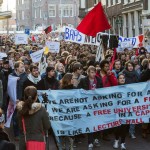[dropcap]A[/dropcap]management building owned by the University of Amsterdam, the Maagdenhuis (or Virgin house in English), has been occupied since February 25th. Since then it has become a flash point in the global “The New University” movement, a movement which pushes for a more democratic and transparent university management that is not motivated purely by financial interests.
Lately however, the movement has broadened to incorporate a greater list of requests to both empower students and staff and ameliorate education as a whole. One of which is to decolonize education. This includes providing a more diverse curricula, employing teachers and management staff from a wider demographic of society and allowing access to education by people regardless of where their families have come from. This is intrinsically linked to the original demands of the protest, as operating purely for profits obstructs access to families who have resided in the area for a shorter amount of time and hence are less financially established.
The iconic Maagdenhuis has recently had a room within the building re-occupied, and a movement has started within a movement! A section of the formerly occupied space has been taken away from the group responsible for the initial occupation, “De Nieuwe Universiteit – voor een democratische universiteit” and has been redecorated with art and energetic meetings by The University of Colour.
The University of Colour, a group allied with De Nieuwe Universiteit – voor een democratische universiteit, is a non-hierarchical initiative that endeavors to decolonize universities, teleporting them out of the past and into the present real world. It wishes to not only change the outdated psyche of the population, but also to make concrete structural changes within the institution. The group consists mainly of students and academics who are completely in accordance with both the goals and the tactics of “The New University” movement. Consequently, an occupation within the occupation has manifested itself.
Paradoxically, the room that is “occupied” has no lock on the door, as it reflects the will to move forwards into a borderless world. Hence, to prevent alienation, it is opened permanently to all persons within the building. Unfortunately, due to current legislation those without papers do not have the rights to study in universities.
The University of Colour could be described as an open and welcoming fortress of humanity, rather than a closed off colony that aims to decolonize. Those who have been frequenting the room identify themselves firstly as humans rather than branding themselves with logos of a specific ethnicity or sub-culture.
The debate in Europe, and former European colonies about the Eurocentrism of studies has been intensifying as of late:
In an article titled ‘Why is my university so white? Time for more diversity’ written by New Urban Collective, the issues of raising diversity was brought to the fore:
“Institutional whiteness is often taken as the norm, but is it really normal that an education center should be so dominantly white in a city where more than 50 percent of youth are from migrant backgrounds? And what does this lack of diversity then say about the university, and society as a whole?”
(Amsterdam, Urban collective)
Similarly, last year there were two campaigns launched in the Netherlands that were inspired by the campaigns initiated in Harvard, Cambridge, Oxford and UCLA using hashtags #I too are VU and #I too am Uva, spreading awareness of micro aggressions.
In a petition called ‘to an inclusive university’ Amsterdam United, an Dutch activist collective stated: “the dominant narrative is that everyone has equal rights and chances, but in practice students and staff experience that this is not the case [with reference to UvA].” Furthermore, they also called for a “decolonization of the curricula, and to give room for reflection on dominant discourses”.
In South Africa at the University of Cape Town the Student Representative Council demanded the removal of a statue of Cecil Rhodes after which stated “Its [statue] removal will not mark the end but the beginning of the long overdue process of decolonizing this university.”
One of the SRC’s demands was to “Increase the representation of black academics on the currently predominantly white, male decision making bodies which perpetuate institutional racism.”
In England, the current occupations of the London School of Economics and the University of the Arts London have been consciously and actively drawing attention to the Eurocentric nature of the curriculum within their respective universities. They have done this by specifying clauses in their list of demands that highlight their discontent with the current curricula.
It is exciting to witness an illusionary wall which blocks out the utopic vision of a non-hierarchical world being shattered. The current revolution within universities is further proof that teaching and learning are reciprocal processes. The students primarily set parameters, teaching the teachers how not to automatically accept policies from university management. Gone are the days which depict teachers as out-of-touch creatures with narrow mindsets who cordon themselves away from reality by their cane bearing hands.































